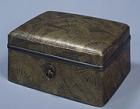Japanese Gallery (Honkan) Room 13
April 1, 2008 (Tue) - June 29, 2008 (Sun)
The Japanese lacquerwork technique of maki-e had advanced tremendously by the Muromachi period. It had reached a stage of such refinement where almost all techniques known to us today were already invented and employed, furthermore employed in combinations, achieving complicated expressions through artful use of lacquer and other material. Influenced by the literary trend of the era, motifs of poetic nature were preferred. Many extant examples of maki-e lacquerwork dating to the Muromachi period are based on famous waka poems.
In addition, the organized trade with Ming China was energetically pursued, also with the support of the government, allowing an immense amount of import wares from China as well as other countries to enter Japan. In the Muromachi period, import articles from China and Korea were treasured as karamono, an expression similar to the term 'chinoiserie' of 18th century Europe. Amongst the military elite with the shogunal house leading the trend, it was also popular to furnish the interior with vast amounts of karamono artifacts. This karamono trend had a multi-faceted effect. In the field of lacquerworks, Chinese choshitsu (lacquer carving) techniques encouraged the advancement of its Japanese counterpart, such as tsuikoku (carved black lacquer) and tsuishu (carved red lacquer) inspiring the kamakura-bori carving, and the technique of chinkin (application of gold to achieve a contrast effect with the lacquer) developing from the Chinese sokin technique. Initially just copied from continental artifacts, the Japanese lacquerwork technique as well as design advanced and grew indigenous to Japan, producing many individual and characteristic wares.
In addition, the organized trade with Ming China was energetically pursued, also with the support of the government, allowing an immense amount of import wares from China as well as other countries to enter Japan. In the Muromachi period, import articles from China and Korea were treasured as karamono, an expression similar to the term 'chinoiserie' of 18th century Europe. Amongst the military elite with the shogunal house leading the trend, it was also popular to furnish the interior with vast amounts of karamono artifacts. This karamono trend had a multi-faceted effect. In the field of lacquerworks, Chinese choshitsu (lacquer carving) techniques encouraged the advancement of its Japanese counterpart, such as tsuikoku (carved black lacquer) and tsuishu (carved red lacquer) inspiring the kamakura-bori carving, and the technique of chinkin (application of gold to achieve a contrast effect with the lacquer) developing from the Chinese sokin technique. Initially just copied from continental artifacts, the Japanese lacquerwork technique as well as design advanced and grew indigenous to Japan, producing many individual and characteristic wares.

